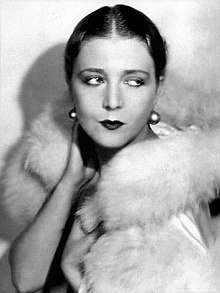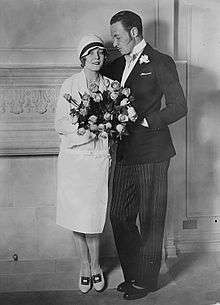Vilma Bánky
Vilma Bánky (born Vilma Koncsics;[2] 9 January 1901 – 18 March 1991) was a Hungarian-American silent film actress, although the early part of her acting career began in Budapest, spreading to France, Austria, and Germany. Bánky was best known for her roles in The Eagle and The Son of the Sheik with Rudolph Valentino and several romantic teamings with Ronald Colman.
Vilma Bánky | |
|---|---|
 Bánky in 1929 | |
| Born | 9 January 1901[1] |
| Died | 18 March 1991 (aged 90) Los Angeles, California, U.S. |
| Occupation | Actress |
| Years active | 1919–1933 |
| Spouse(s) | |
Early life
Bánky was born on 9 January 1901[2] to János Bánky Koncsics (1875–1948) and his wife, Katalin Ulbert (1880–1947) in Nagydorog, Austria-Hungary. Her father was a bureau chief in Franz Joseph's Austro-Hungarian Empire. Shortly after her birth, her father, a police sergeant was transferred to Budapest, and the family relocated. She had two siblings – an older brother, Gyula and a younger sister, Gizella. After graduation from secondary school, Bánky (as she would later be known) took courses to work as a stenographer, but was offered a role in a film.
Her first film appearance was in the now lost film, Im Letzten Augenblick (In the last moment), directed by Carl Boese in Germany in 1919. On a trip to Budapest in 1925, Hollywood film producer Samuel Goldwyn discovered and signed her to a contract. Both her mother and father were vehemently against Bánky's acting career as was her fiancé; nonetheless, she left for the United States in March 1925, arriving to a great deal of fanfare.
Career
She was hailed as "The Hungarian Rhapsody" and was an immediate hit with American audiences. The New York Times remarked in its review of her first American film, The Dark Angel (1925), that she "is a young person of rare beauty ... so exquisite that one is not in the least surprised that she is never forgotten by Hillary Trent"[3] (the movie's leading male character who decides to allow his family and fiancee to believe him dead rather than place what he perceives as the burden on them of a life caring for a blinded war veteran).

She appeared opposite silent great Rudolph Valentino in The Eagle (1925) and The Son of the Sheik (1926). Valentino reportedly was fascinated by Vilma, and he chose her as the leading lady in the films. She also appeared opposite Ronald Colman in a series of love stories, including The Dark Angel and The Winning of Barbara Worth. It commonly is believed that her thick Hungarian accent cut her career short with the advent of sound; however, she began losing interest in films and wanted to settle down with Rod La Rocque and simply be his wife. By 1928, she had begun announcing her intention to retire in a few years.
Of her 24 films, eight exist in their entirety (Hotel Potemkin, Der Zirkuskönig [The King of the Circus with Max Linder], The Son of the Sheik, The Eagle, The Winning of Barbara Worth, The Night of Love, A Lady to Love, and The Rebel), and three exist in fragments (Tavaszi szerelem in scattered bits, the first five reels of The Magic Flame, and an incomplete copy of Two Lovers).
Post-acting career
Her post-Hollywood years were spent selling real estate with her husband and playing golf, her favorite sport. In 1981, Bánky established an educational fund, the Banky–La Rocque Foundation.
Personal life and death

She married actor Rod La Rocque in 1927; they remained married until his death in 1969. They had no children.[4]
Bánky died on 18 March 1991, from cardiopulmonary failure, aged 90, but notice of her death was not made public until the following year. She was reportedly upset that no one had come to visit her in her last years, and directed her lawyer to make no mention of her death.[4][5] Her ashes were scattered at sea where her husband's had been consigned.
For her contributions to the film industry, Bánky received a motion pictures star on the Hollywood Walk of Fame in 1960. Her star is located at 7021 Hollywood Boulevard.[6]
In popular culture
She is mentioned in Stephen Sondheim's early musical Saturday Night. Her name is also brought up in the Gloria Swanson vehicle "Sunset Boulevard" along with that of her husband, Rod La Rocque. In the 1971 film They Might Be Giants, a psychiatric patient who believes he is Rudolph Valentino is told "my best to Vilma Bánky".
Filmography
| Year | Title | Role | Notes |
|---|---|---|---|
| 1919 | Im letzten Augenblick | ||
| 1921 | Veszélyben a pokol | Aurora | |
| Tavaszi szerelem | |||
| Galatea | Galathea | ||
| 1922 | Schattenkinder des Glücks | Helen Blaas | |
| Kauft Mariett-Aktien | |||
| A Halott szerelme | Alternative title: Das Auge des Toten | ||
| 1923 | The Portrait | Alternative title: L'image | |
| 1924 | Die letzte Stunde | Mabel | Alternative title: Hotel Potemkin |
| Das verbotene Land | Alternative title: Das Leben des Dalai Lama | ||
| Der Zirkuskönig | Ketty | Alternative title: King of the Circus | |
| The Wonderful Adventure | Bessy Ferguson | Alternative title: Das schöne Abenteuer | |
| 1925 | The Dark Angel | Kitty Vane | Lost film |
| Soll man heiraten? | Alternative title: Intermezzo einer Ehe in sieben Tagen | ||
| The Eagle | Miss Mascha Troekouroff | Credited as Vilma Banky | |
| 1926 | Son of the Sheik | Yasmin, André's Daughter | Credited as Vilma Banky |
| The Winning of Barbara Worth | Barbara Worth | ||
| 1927 | The Night of Love | Princess Marie | |
| The Magic Flame | Bianca, the Aerial Artist | Lost film, although the first five reels are rumored to exist | |
| Die Dame von Paris | Alternative title: The Lady from Paris | ||
| 1928 | Two Lovers | Donna Leonora de Vargas | Incomplete film |
| The Awakening | Marie Ducrot | Lost film | |
| 1929 | This Is Heaven | Eva Petrie | |
| 1930 | A Lady to Love | Lena Shultz | |
| Die Sehnsucht jeder Frau | Mizzi | ||
| 1933 | The Rebel | Erika Leroy | (final film role) |
Bibliography
- Schildgen, Rachel A. More Than a Dream: Rediscovering the Life & Films of Vilma Banky; ISBN 978-0-9827709-2-4.
References
- National Archives of Hungary: microfilm 30790, image 291, fiche 3.
- Hungarian civil registration document from Nagydorog, available through LDS records; film number 1793002 Items 4–5
- The New York Times Directory of Film, 'The Dark Angel' film review by Mordaunt Hall, 12 October 1925, pg. 17, Arno Press and Random House, USA, 1971
- "Vilma Banky, Hollywood Star With Short but Influential Career". The New York Times. 12 December 1992. Retrieved 13 March 2017.
- Donnelley, Paul (1 June 2003). Fade To Black: A Book Of Movie Obituaries (2 ed.). Omnibus Press. p. 108. ISBN 0-7119-9512-5.
- "Hollywood Walk of Fame - Vilma Bánky". walkoffame.com. Hollywood Chamber of Commerce. Retrieved 13 November 2017.
External links
| Wikimedia Commons has media related to Vilma Bánky. |
- Vilma Bánky on IMDb
- Vilma Bánky at AllMovie
- Vilma Bánky: Hungarian Rhapsody, vilma-banky.com
- Information on Vilma Bánky, szineszkonyvtar.hu
- Photographs of Vilma Bánky, film.virtual-history.com
- "Vilma Bánky profile". NYPL Digital Gallery.
- Vilma Bánky at Find a Grave